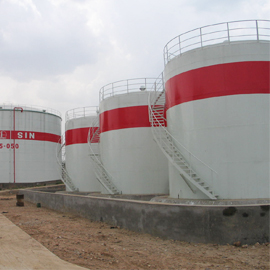FUXI ® ANTISTATIC PAINT
Cantidad : 12000 tons Precio : $2.5/kg-6.8/kg
The anti-corrosion paint is used for the inner wall of the oil tank. The basic function is to protect the steel oil tank from corrosion, protect the oil from pollution, and prevent static electricity.
Epoxy resin is the base material, It is composed of special conductive material, anti-rust pigments, curing agents and additives. In addition, it has good corrosion resistance to media (kerosene, diesel, gasoline, etc.)
Types of FUXI ® Antistatic Paint
Non-Carbon Epoxy Antistatic Anticorrosive Finish
Non-Carbon Epoxy Antistatic Anticorrosive Intermediate Paint
Non-Carbon Epoxy Antistatic Anticorrosive Primer
The Advantages of Antistatic Paint
The film is with excellent corrosion resistance and stable electrical resistivity
Excellent resistance to without polluting oil
Excellent heat resistance (≤200 ℃)
The tough film with abrasion resistance and easy application.
It is characterized by low surface electricity resistance, good conductivity, and quick elimination of static charge.
Epoxy Antistatic Paint
The new type of anti static spray paint is divided into solvent type and solvent-free type. The former is formulated with epoxy resin, additives, composite conductive pigments, thinning agents, coloring pigments and mixed solvents, and polyamide resin is used as the hardener. The latter is with modified polyamine as the hardener. The improved coating still has the properties of epoxy resin coating. The paint film has excellent adhesion to polar substrates such as metal (steel, aluminum, etc.), ceramic, glass, concrete, wood, terrazzo, and epoxy resin insulating plates; meanwhile, its chemical resistance is excellent. There is no hydroxy, ether bond and ester bond, so the alkali resistance is particularly outstanding. Also, because the epoxy resin coating has a three-dimensional network structure after curing, and is resistant to oil impregnation, it has been widely used in oil tankers, tanker ships, and aircraft fuel tanks as internal lining.
Epoxy Antistatic Paint Applying Method
Antistatic additives for coatings can be applied by high-pressure airless spraying, or brushing or compressed air spraying.
1. Brushing
When applying anti static wall paint, make the paint brush dipped in an appropriate amount of paint and distribute it on a range of the surface. First extend it horizontally, and then straighten it vertically to make the paint evenly distributed. You can also expand vertically, then straighten out horizontally, step by step, and don't miss out.
2. Compressed air spraying
Compressed air spraying is to attract (or press) the paint from the pot-shaped container to the spray gun by compressed air. At 0.2-0.5Mpa, antistatic epoxy paint is mixed and atomized at the spraying mouth and sprayed on the coated surface to obtain a uniformly distributed coating. The paint used for compressed air spraying should be thinner than that applied by brush and roller, so it is necessary to add 5-15% thinner to the paint.
3. High pressure airless spraying
High-pressure airless spraying usually uses compressed air to drive a high-pressure pump to suck and pressurize the paint to 10-25Mpa, through a high-pressure hose and spray gun, and finally spray out through a nozzle with an olive-shaped mouth. When the paint leaves the nozzle, it atomizes into very fine particles and sprays onto the coated surface to form a uniform coating film.
Environmental Restrictions on Epoxy Antistatic Paint
1. Moisture and humidity limits
Epoxy antistatic paint is not recommended to be applied in the open air under hot sun exposure and rain, snow, and fog; epoxy antistatic paint is not recommended to be applied on the metal surface with dew due to fog or humidity, unless the paint manufacturer makes other recommendations. Generally speaking, application should be carried out under the condition of a relative humidity lower than 85%. All surfaces should be completely dry before and during application of epoxy antistatic paint and within 24 hours after painting.
2. Time Limit
Generally, the anti static coatings should be painted on the sandblasted surface within 4 hours after the sandblasting is completed. Exceeding this period, the surface should be treated for a second time. This time limit can be modified to 4 hours or more or less depending on the temperature and humidity control implemented. The main criterion should be that no rust film is formed on the surface before the primer is applied. If any rust film is formed, the surface should be sandblasted before applying the primer. The interval of painting should be strictly controlled according to the painting process.
3. Epoxy Paint Temperature Limit
Unless the paint manufacturer has special regulations and suggestions, generally speaking, anti static coatings should be carried out under the conditions of 10℃~32℃. Anti static coatings should not be applied when the ambient temperature is lower than 5°C or when the temperature is expected to drop to 0°C before the paint dries. Steel with a temperature higher than 50°C should not be painted unless the paint is specially formulated for application at this temperature. When steel is painted in hot climates, precautions should be taken to ensure that the specified dry film thickness of the paint is obtained. Welding parts can only be painted after 72 hours of welding. Construction can only be carried out when the temperature of the substrate is 3°C above the dew point. Do not paint when there is condensation on the treated surface.
4. Clean
The process of applying of anti static epoxy paint and paint film drying should keep in a clean air, and do not paint in a dusty environment.
FAQs of Antistatic Paint
Will the antistatic paint contaminate the oil in the storage tank?Will the antistatic paint contaminate the oil in the storage tank?
Our antistatic paint contains no carbon, but a metal conductive element. It has good protection to the interior tank wall and excellent resistance to the oil, and will not pollute the oil in the storage tank.
How does antistatic paint work?
It is characterized by low surface electricity resistance, good conductivity, and quick elimination of static charge.
Epoxy resin is the base material, It is composed of special conductive material, anti-rust pigments, curing agents and additives. In addition, it has good corrosion resistance to media (kerosene, diesel, gasoline, etc.)
As a coating paint manufacturer, we have types of industrial paint coating for sale, if you have needs, please contact us.
Persona a contactar : Tang Crystal , 022 86873850
Buen trato: comprar del vendedor
Por favor, lea nuestras condiciones de uso. También puede visitar nuestras preguntas frecuentes y ver nuestra información sobre los riesgos relacionados con la falsificación.
|
Esta página es acerca de los importadores y exportadores de FUXI ® ANTISTATIC PAINT Buscar en la categoria : B2B Servicios Buscar en la categoria : fuxi, antistatic, paint |
Wednesday 08 April 2015
Cantidad : 100 grams - Precio : 7USD
- Liquid silicone rubber Specifications - mold liquid silicone rubber 1.favorable hardness 2.less than 2% shrinkage 3.catalyst: odorless Liquid silicone rubber Application: 1.Unsaturated polyester resins, epoxy resins, polyurethane resins. 2.Polyurethane elastomers. 3.Natural...
Guangzhou OTT New Materials Co.,Ltd.
- 510800 - Guangzhou
- 86 020 86819712
Sunday 28 September 2014
- Specifications - 1.Great Rigidity and Strength 2.Excellent Flexibility Force 3.ISO9001, various sizes 4.Anti-corrossion TID Tech offers one of the most comprehensive range of Duct Rodders available anywhere in the world - from the smallest Φmm 4.5 to Φ16mm Duct Rodders...
TID technology development Co.,Ltd
- tidpower
- 714000 - Shaanxi
- +86 913 2112960
Sunday 28 September 2014
- Specifications - Long Handle Fiberglass Tree Pruner 1. Ratchet 2. Lightweight 3. Length and voltage class can made as yours 4. Collapsibl 1.Length: up to 26'. 2.Color: safety yellow , orange ,green or customer required color. 3.Locking position: Any length or every stage...
TID technology development Co.,Ltd
- tidpower
- 714000 - Shaanxi
- +86 913 2112960









